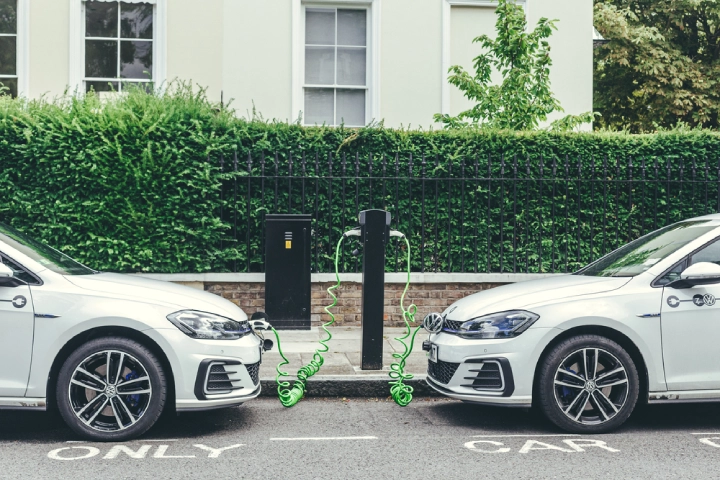
Electric vehicles (EVs) are now a significant portion of UK car sales, with new registrations reaching record highs last year.
267,203 new battery electric vehicles (BEVs) made their way onto British roads in 2022 – accounting for 16.6% of all new cars sold – along with 101,414 plug-in hybrids (6.3%).
What’s more, those record sales came despite the effects of supply chain disruptions on new car production.
While there is clearly a demand for electric vehicles, where is it coming from around the UK? And will it continue into 2023?

Electric vehicle registrations around the UK
According to the most recent publicly available datasets published by the Driver and Vehicle Licensing Agency (DVLA) – covering up to the end of September 2022 – the five local authorities with the most electric vehicles registrations were:
- Stockport – 42,567
- Swindon – 25,877
- Leeds – 23,856
- Milton Keynes – 23,796
- Windsor and Maidenhead – 22,926
However, due to the high volume of company keepership of BEVs, this may not be the whole story.
As Field Dynamics noted in early 2021, many company cars and leased vehicles are registered in the local authority of the leasing centre, making it unlikely that some of the apparent top EV locations are actually home to that many BEVs. For example, Stockport, which has by far the most EV registrations in the country, is also home to a large leasing centre.
But if we examine personal EVs alone, the number distribution looks clearer:
The downside to this method is that it can't account for the considerable number of EVs – more than half – owned by companies or leased, yet there is no effective way of knowing their actual locations. We can, however, take the number of personal EVs as at least roughly indicative of general uptake, given that it reveals a reasonably similar distribution – minus the outliers like Stockport and Windsor.
As such, nationally, we see there is a higher uptake in the south of England, parts of Yorkshire and the North East. Meanwhile, there is a distinct lack in the areas of the North West, Wales and most of the Midlands. The single local authorities with the greatest numbers are:
- Buckinghamshire – 4,070
- Barnet – 3.094
- Wiltshire – 2,785
- Cornwall – 2,333
- Cheshire East – 2,325
The future of EVs in the UK
The overall trend in electric vehicle sales is distinctly upward, with the growth in total registrations year-on-year solidly above 50% since Q4 2019.
However, while 2022 saw the highest number of EVs ever sold in the UK, the year-on-year growth of 73% actually declined from its peak in Q3 2021 of 101%.
Considering supply chain issues in 2022, this could be seen as a victory in difficult circumstances or a potential sign that interest is starting to reach its peak.
In the former camp is EV leasing company DriveElectric, which believes that 2023 will see a marked increase in sales – as many as 448,000 – compared to 2022.
According to the company’s calculations, this would equate to a 24.9% market share for BEVs, an 8.3 percentage point increase year-on-year from the 16.6% market share in 2022.
DriveElectric CEO Mike Potter said: “We have seen [a] preference for electric vehicles continue to grow, as more than 50% of people planning to buy a car have stated they will choose from either fully electric, plug-in hybrid or hybrid vehicles.
“There has also been a shift in the vehicle market as younger drivers choose their cars. In the 2021 census, it was revealed that over half of the young drivers in the UK will most likely switch to electric cars in the next decade”.
Disparity in electric vehicle charging points
While the interest in electric vehicles around the UK is significant and demonstrates a potential to accelerate, access to vital public charging points is far from uniform.
In fact, the number of public charging points per 100,000 people and per EV varies significantly in different parts of the country.
For example, many boroughs of London have large numbers of public charging points and a single-digit ratio of charging points to personal EVs – even as low as 1:1 (company and leased cars have been excluded to account for the location issues mentioned earlier).
In fact, the top eight local authorities for relative access to charging points are all in London.
This is in stark contrast to the lowest authorities on the list. The bottom half of local authorities have between nine and 135 times as many EVs per charging point, and one area, the Isles of Scilly, had zero public points for 39 EVs.

While this disparity is bound to change – some local authorities are investing faster than others but a like-for-like comparison for Q1 2023 is not yet possible – it clearly demonstrates the potential roadblocks toward greater EV uptake.
Like with other forms of transport in the UK, such as London versus wider UK public transport and southern versus northern rail infrastructure, there is a risk that geography will determine where and how widespread EV usage becomes a reasonable prospect.
Given the government’s ambitions to end the sale of new petrol and diesel cars by 2035 and the increasing implementation of Ultra Low Emission Zones, the pressure is on for the supply of EV-friendly infrastructure to meet demand.
[Read more: The need to grow London’s EV infrastructure at speed and scale]






